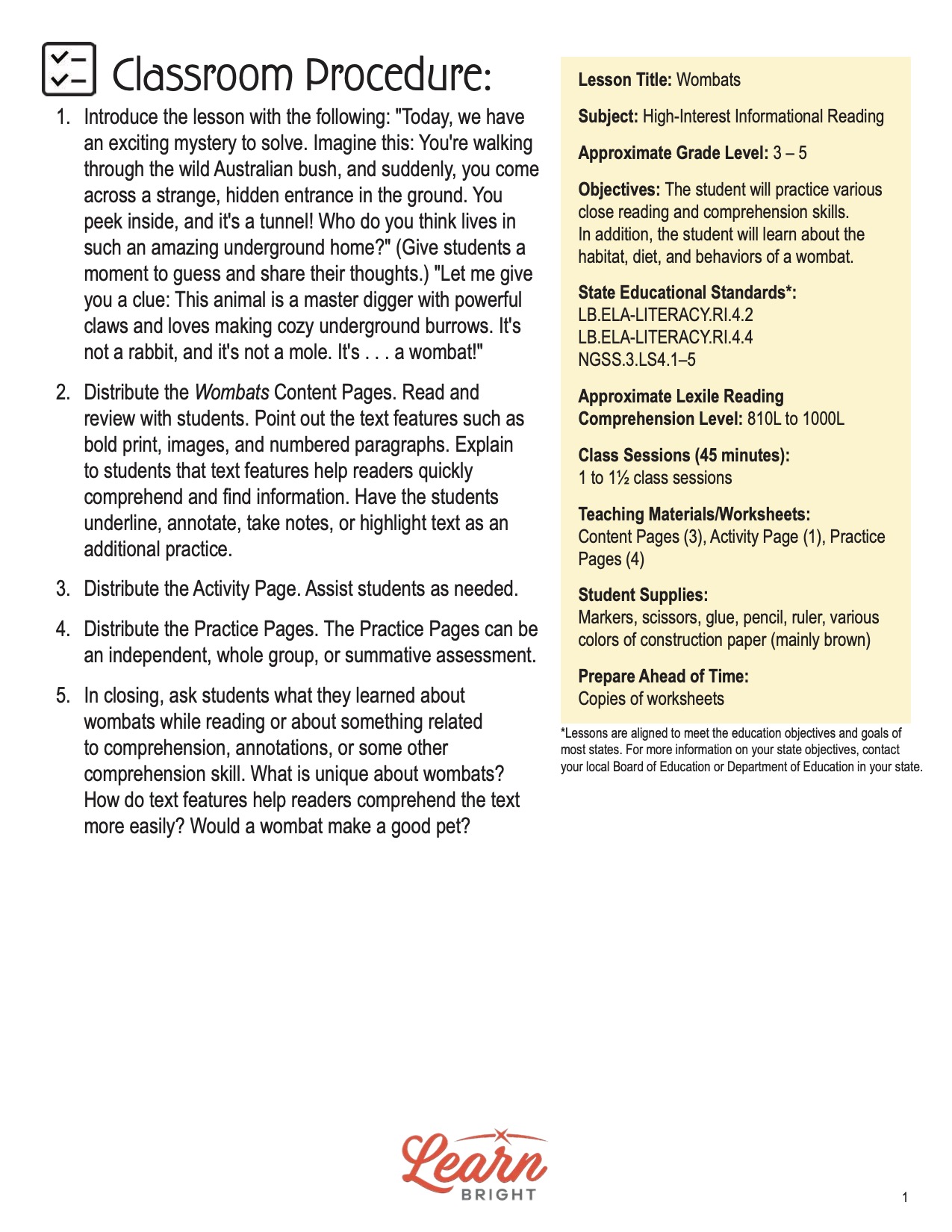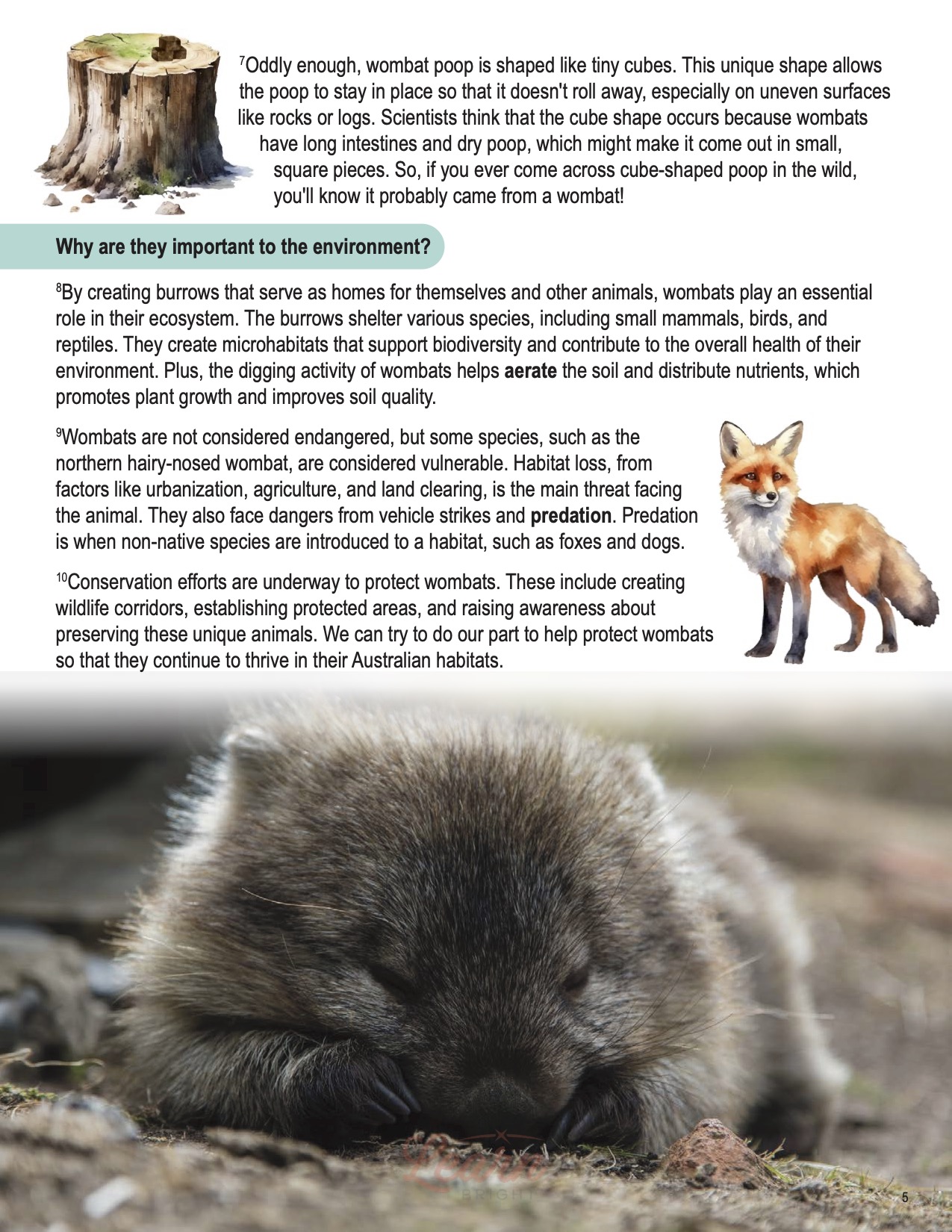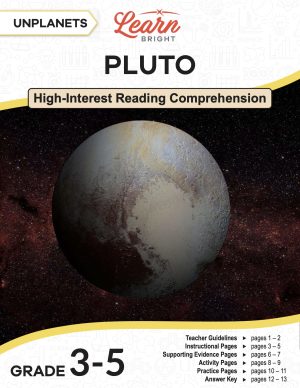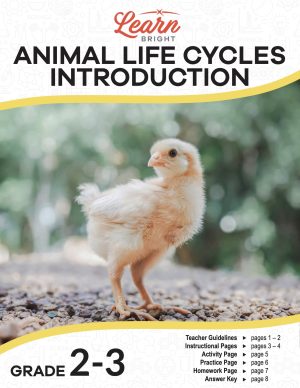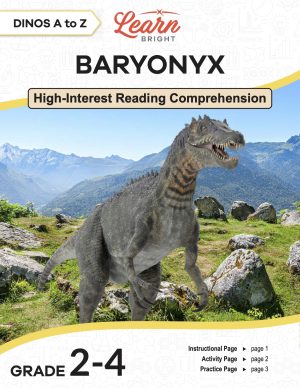Description
What our Wombats lesson plan includes
Lesson Objectives and Overview: Wombats is a high-interest reading comprehension lesson plan. As such, students will practice various close reading and comprehension skills. In addition, they will learn about the wombat’s habitat, diet, and behaviors. This lesson is for students in 3rd grade, 4th grade, and 5th grade.
Classroom Procedure
Every lesson plan provides you with a classroom procedure page that outlines a step-by-step guide to follow. You do not have to follow the guide exactly. The guide helps you organize the lesson and details when to hand out worksheets. It also lists information in the yellow box that you might find useful. You will find the lesson objectives, state standards, and number of class sessions the lesson should take to complete in this area. In addition, it describes the supplies you will need as well as what and how you need to prepare beforehand. The activity in this lesson requires markers, scissors, glue, pencil, ruler, and various colors of construction paper (mainly brown).
Teacher Notes
The paragraph on this page provides a little more information or guidance on what to expect from the lesson. It explains that you can teach this lesson in a whole-class setting or as an independent, small-group activity. You can use the blank lines to record any thoughts or ideas you have as you prepare.
WOMBATS LESSON PLAN CONTENT PAGES
What Is a Wombat?
The Wombats lesson plan contains three content pages. It begins by providing a box of background information about this animal. This mammal lives in Australia with many of its marsupial cousins. They are herbivores and thus eat only plants. Their life span is generally 15 years in the wild but up to 30 years in captivity.
Wombats are unique and fascinating animals. They have sturdy, compact bodies with strong legs and sharp claws, making them excellent diggers. Their fur is thick and coarse, ranging from gray to brown, which helps them blend into their surroundings. Wombats have small eyes and ears but a keen sense of smell, which they use to navigate and find food. They’re marsupials, so the females have a pouch in which baby wombats develop.
These furry creatures are native to Australia, where they live in several habitats, including forests, grasslands, and scrublands. They prefer areas with thick vegetation and plenty of space to dig burrows, which serve as their homes. Wombats are primarily solitary animals, meaning they choose to live alone rather than in groups. Each wombat has its own burrow, which it digs with its powerful claws. It provides a safe place to rest and raise their young.
Speaking of caring for their young, wombat mothers are very attentive. A baby wombat, called a joey, is born after a short gestation period of about 20 to 30 days. The joey crawls into its mother’s pouch, continuing to develop for several months. The joey receives specially formulated milk inside the pouch to meet its nutritional needs. As the joey grows, it eventually ventures out of the pouch. The young wombat stays close to its mother for protection and guidance.
What Do They Eat?
Wombats are herbivores, so they eat plants, and their favorite food is grass. They use their excellent sense of smell to locate food, sniffing fresh vegetation to munch on. Wombats spend most of their time grazing and munching on grasses, roots, and other plants they find in their habitat. They use their sharp claws and strong teeth to dig up roots and tubers and break tough grasses and leaves apart. They are nocturnal animals, meaning they are most active at night. So, they do most of their feeding during the cooler hours of the evening and early morning.
Other Interesting Facts
One cool fact about wombats has to do with their ability to dig. These marsupials are remarkable diggers and use their powerful claws to excavate burrows. They have strong, sturdy claws and powerful legs that enable them to create elaborate underground tunnel systems with multiple entrances and chambers. The burrows, called warrens, serve as their homes and provide protection from predators and extreme weather conditions. Some burrows can be as long as 30 meters (nearly 100 feet) and have several rooms for sleeping, nesting, and raising young.
Unlike other marsupials with pouches that open toward the front, wombats have pouches that face backward. This unique adaptation helps protect the young from dirt and debris while the wombats dig. They kick their strong hind legs out with incredible force when threatened, like martial arts masters! They can knock down animals much larger than themselves with these powerful kicks. Wombats also have thick, tough skin and a layer of cartilage in their rumps, which acts as natural armor to protect them from bites and scratches.
Oddly enough, wombat poop is shaped like tiny cubes. This unique shape allows the poop to stay in place so that it doesn’t roll away, especially on uneven surfaces like rocks or logs. Scientists think that the cube shape occurs because wombats have long intestines and dry poop, which might make it come out in small, square pieces. So, if you ever come across cub
Why Wombats Are Important
By creating burrows that serve as homes for themselves and other animals, wombats play an essential role in their ecosystem. The burrows shelter various species, including small mammals, birds, and reptiles. They create microhabitats that support biodiversity and contribute to the overall health of their environment. Plus, the digging activity of wombats helps aerate the soil and distribute nutrients, which promotes plant growth and improves soil quality.
Wombats are not considered endangered, but some species, such as the northern hairy-nosed wombat, are considered vulnerable. Habitat loss, from factors like urbanization, agriculture, and land clearing, is the main threat facing the animal. They also face dangers from vehicle strikes and predation. Predation is when non-native species are introduced to a habitat, such as foxes and dogs.
Conservation efforts are underway to protect wombats. These include creating wildlife corridors, establishing protected areas, and raising awareness about preserving these unique animals. We can try to do our part to help protect wombats so that they continue to thrive in their Australian habitats.
WOMBATS LESSON PLAN WORKSHEETS
The Wombats lesson plan includes two worksheets: an activity worksheet and a practice worksheet. Each one will help students solidify their grasp of the material they learned throughout the lesson. You can refer to the classroom procedure guidelines to know when to hand out each worksheet.
WOMBAT WARREN ACTIVITY WORKSHEET
For this activity, students will design a poster that illustrates what a wombat’s burrow (warren) looks like. The page lists the steps to follow and the details students need to include for their posters. Hang up the posters in your classroom or hallway to showcase students’ work.
REVIEW PRACTICE WORKSHEET
The practice worksheet requires students to answer a series of 11 questions. These questions all relate to the content pages, so students will need to refer to them often for the answers. In addition, each question provides which reading tool the question corresponds to, such as text feature, vocabulary, or comprehension.
Worksheet Answer Keys
At the end of the lesson plan document is an answer key for the practice worksheet. The correct answers are all in red to make it easier for you to compare them with students’ responses. If you choose to administer the lesson pages to your students via PDF, you will need to save a new file that omits these pages. Otherwise, you can simply print out the applicable pages and keep these as reference for yourself when grading assignments.


